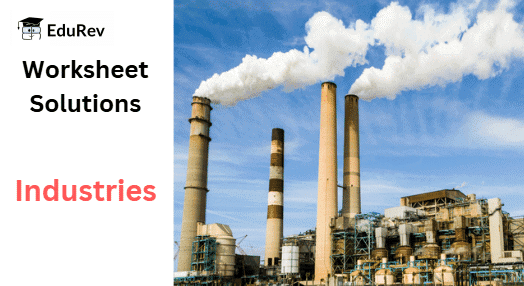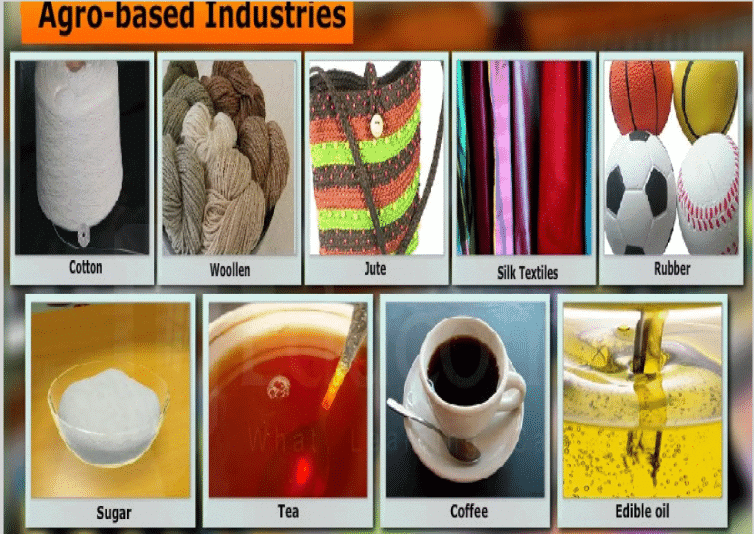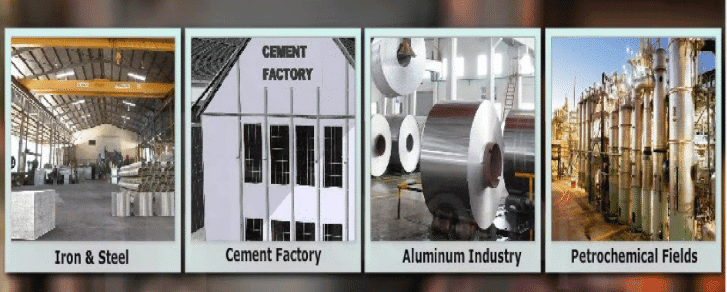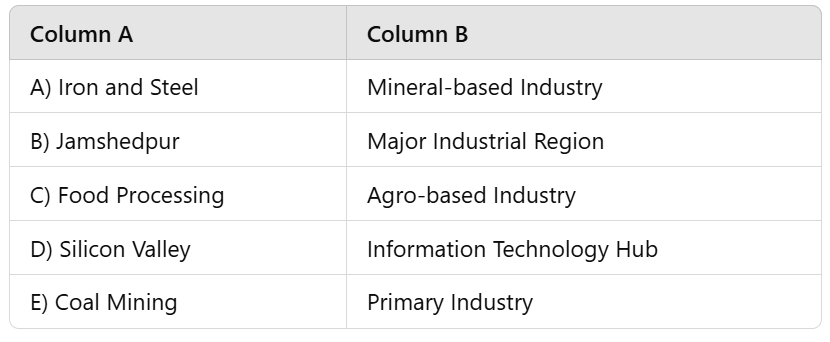Industries Class 8 Worksheet Geography Chapter 4
| Table of contents |

|
| Multiple Choice Questions (MCQs) |

|
| Fill in the Blanks |

|
| True or False |

|
| Match the Following |

|
| Very Short Answer Questions |

|
| Short Answer Questions |

|

Multiple Choice Questions (MCQs)
Q1: Which of the following is an example of an agro-based industry?
A) Iron and Steel
B) Cotton Textile
C) Coal Mining
D) Information Technology
Ans: B) Cotton Textile
The correct answer is B) Cotton Textile, which is an example of an agro-based industry. Here’s why:
- Agro-based industries rely on products derived from agriculture.
- Cotton textiles use cotton, a natural fibre, as their primary raw material.
- This industry plays a vital role in the economy by providing jobs and supporting farmers.
In contrast, the other options are:
- A) Iron and Steel - This is a mineral-based industry.
- C) Coal Mining - This is also a mineral-based industry.
- D) Information Technology - This falls under the service sector.

Q2: What type of industry is involved in the extraction of coal?
A) Service Industry
B) Agro-based Industry
C) Mineral-based Industry
D) Cottage Industry
Ans: C) Mineral-based Industry
 Examples of Mineral Based Industry
Examples of Mineral Based Industry
Q3: Which industry is considered a 'Sunrise Industry'?
A) Information Technology
B) Textile Industry
C) Iron and Steel Industry
D) Coal Mining Industry
Ans: A) Information Technology
The industry considered a 'Sunrise Industry' is:
- Information Technology
Emerging industries, also known as Sunrise Industries, include:
- Wellness
- Hospitality
- Knowledge
Q4: The major iron and steel producing countries include:
A) India
B) Australia
C) Japan
D) All of the above
Ans: D) All of the above
The major iron and steel producing countries are:
- India
- Australia
- Japan
Therefore, the correct answer is: D) All of the above
Q5: Which of the following is a characteristic of large scale industries?
A) Low capital investment
B) High volume of production
C) Use of manual labor
D) Small market reach
Ans: B) High volume of production
- The characteristic of large-scale industries is high volume of production.
- These industries typically produce goods in large quantities.
- They often require significant investment in capital and advanced technology.
- Large-scale industries can serve a broader market compared to smaller industries.
Fill in the Blanks
Q1: Industries that use products from the sea are called ___________ based industries.
Ans: Industries that use products from the sea are called Marine based industries.
Marine based industries focus on the utilization of resources obtained from the ocean, such as fish and other seafood products.

Q2: The process of extracting metals from their ores is known as ___________.
Ans: The process of extracting metals from their ores is known as Smelting.
Smelting is a metallurgical process that involves heating ores to extract metals, often involving chemical reactions.
Q3: ___________ industries produce goods for personal consumption.
Ans: Cottage industries produce goods for personal consumption.
Key points include:
- They are often small-scale and operated from home.
- Examples include handicrafts, pottery, and basket weaving.
- These industries rely on manual skills rather than heavy machinery.
Q4: The ___________ sector includes industries owned and operated by the government.
Ans: The Public sector includes industries owned and operated by the government.
The public sector comprises government-owned entities that provide services and goods to the public, often funded by taxpayer money.
Q5: An industrial system consists of inputs, processes, and ___________.
Ans: An industrial system consists of inputs, processes, and Outputs.
Outputs are the final products produced by an industrial system after processing the inputs through various stages.
True or False
Q1: All industries are part of the service sector.
Ans: False
Industries are part of the secondary sector as they involve manufacturing and production of goods, like steel or textiles. The service sector (tertiary) focuses on providing services like tourism and education, not production.
Q2: Agro-based industries use plant and animal products as raw materials.
Ans: True
Agro-based industries use raw materials from plants and animals. Key points include:
- They rely on products like crops and livestock.
- Examples include food processing, dairy, and textile industries.
- These industries transform raw materials into finished goods.
Q3: Industrial disasters cannot be avoided with proper safety measures.
Ans: False
Industrial disasters can be avoided with measures like separating residential areas, improving fire safety, and limiting toxic storage
Q4: Jamshedpur is known for its iron and steel industry.
Ans: True
Jamshedpur is a significant centre for the iron and steel industry in India. Key points include:
- Home to Tata Steel, one of the largest steel manufacturers.
- Strategically located near essential resources like iron ore and coal.
- Supports various industries, contributing to regional economic growth.
Q5: The textile industry is a type of mineral-based industry.
Ans: False
The textile industry is an agro-based industry as it uses raw materials like cotton and wool from agriculture, not minerals.
Match the Following

Ans: 
Very Short Answer Questions
Q1: What is the first stage in the manufacturing process of a notebook?
Ans: The first stage is cutting down trees to obtain wood.
Q2: Name an example of an agro-based industry.
Ans: Food processing industry is an example of agro-based industry.
Q3: What is the primary raw material for the iron and steel industry?
Ans: The primary raw materials are iron ore, coal, and limestone.
Q4: What type of industry is Maruti Udyog Limited categorized as?
Ans: Maruti Udyog Limited is categorized as a joint sector industry.
Q5: What disaster occurred in Bhopal in 1984?
Ans: A gas leak incident, releasing poisonous Methyl Isocyanate gas.
Short Answer Questions
Q1: What is the first step in making a notebook from a tree?
Ans: The first step in making a notebook from a tree is cutting down the tree. After the tree is cut, it is taken to a place called a pulp mill to start making paper.
Q2: Can you name two types of materials that are used to make paper?
Ans: Two types of materials that are used to make paper are wood and chemicals. The wood is turned into pulp, and then mixed with chemicals to make paper.
Q3: What are agro-based industries?
Ans: Agro-based industries are industries that use plants and animals to make products. Examples include food processing, dairy products, and cotton textiles.
Q4: What is one reason why industries are located near rivers?
Ans: Industries are located near rivers because they need water for making things. Rivers also help to transport materials and finished products easily.
Q5: What happened in the Bhopal disaster?
Ans: In the Bhopal disaster, a very harmful gas leaked from a factory, causing many people to get very sick and some to die. It was a big accident that happened because of a problem with the factory's equipment.
You can access the solutions to this worksheet here.
|
69 videos|556 docs|46 tests
|
FAQs on Industries Class 8 Worksheet Geography Chapter 4
| 1. What are the different types of industries mentioned in the article? |  |
| 2. How do industries impact the economy? |  |
| 3. What is the significance of the agricultural industry? |  |
| 4. How does the manufacturing industry differ from the service industry? |  |
| 5. What are the challenges faced by industries today? |  |















